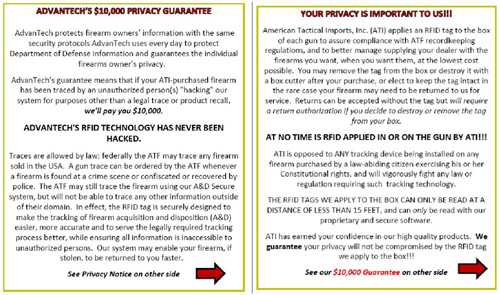Two gun distributors—American Tactical Imports (ATI) and AmChar Wholesale—are installing a radio frequency identification solution from Annapolis, Md., logistics-management software firm AdvanTech Inc. to help them track firearms passing through their facility. The two sister companies operate out of a single large facility located in Rochester, N.Y. AmChar is also marketing AdvanTech’s RFID solution to its retailers. The solution involves the attachment of EPC Gen 2 RFID tags to guns, and the use of fixed and handheld RFID readers to determine goods’ locations as they are received at ATI’s and AmChar’s Rochester warehouse, as well as when they are shipped to gun shops or other customers. Retailers could then use the readers themselves to track the firearms’ arrival and sale.
Over the course of the past 12 months, AdvanTech has been developing the solution’s firearm-tracking software, known as A&D (Acquisition and Disposition) Secure, which manages RFID read data, says Paul Lowe, AdvanTech’s director of technology integration services. The firearms industry is traditionally low-tech, he explains, and distributors and retailers usually record weapons sales in paper notebooks. “There have been various computerized systems,” he explains, but these require workers to scan a bar code or type information into a system in order to enter data regarding a weapon’s receipt or sale.

(Click here to view a larger version of this image.)
Typically, distributors receive firearms directly from manufacturers, and then store the weapons within locked areas until they are sold and shipped to a retailer. Even with the security of locked doors, however, the firearms must be closely managed. A company must be able to account for every item, including when it was received, as well as when and to where it was shipped. Inspectors for the Bureau of Alcohol, Tobacco, Firearms and Explosives (ATF) pay visits to wholesalers and distribution centers, in order to ensure that all weapons are secured and accounted for. Most companies either maintain a written record of each weapon received and then sold, including its serial number and manufacturer, which can be presented to officials, or use a computerized system into which employees enter data by scanning a bar code and inputting other details.
“The ATF monitors compliance with surprise inspections,” Lowe says, “and they can find innocent errors.” Mistakes related to firearm management, including misplacing or losing a weapon, can be costly for such companies, which can be fined or lose their business license.
With AdvanTech’s solution, a weapons manufacturer places an Avery Dennison AD-826 EPC Gen 2 RFID tag containing an Impinj Monza 3 chip on the container of each weapon destined for ATI’s warehouse. One manufacturer is currently applying the tags to its products as part of the pilot, Lowe says, though the firm has requested that it not be named.
The RFID tag is intended to be removed from the weapon, either by the consumer or by the retailer before the consumer takes the item home. An insert in the weapon’s box describes the tag’s function to consumers and instructs them as to how the tag can be removed.
ATI’s warehouse staff will read the tags as firearms are received at its dock doors, as well as when the goods are stored within locked cages, removed from those cages and eventually shipped. In this way, ATI can ensure that weapons do not end up missing during the time between their receipt and storage in the locked cages, or following their removal from the cages prior to shipment to a retailer. According to Lowe, the warehouse staff will read the tags by means of six fixed Impinj Speedway Revolution R420 readers installed at chokepoints, for a total of 24 antennas, and also use handheld Workabout Pro readers, provided by Motorola Solutions‘ Psion division, for inventory tracking and other processes.
A&D Secure software, residing on ATI’s back-end system, will manage the read data and store details indicating which firearm was received, stored or shipped, as well as when this occurred. RFID tag reads are compared against shipping orders in the A&D software as well, and exception reports will be sent to management in the event that a mistake occurs, such as a firearm not being included in a shipment, or being sent to the wrong customer. What’s more, the software will allow a specified amount of time for a firearm to arrive at storage following its receipt at the dock doors, as well as a similar window of time for the staging of weapons after their removal from the locked cages but prior to their being loaded onto a delivery truck. If the amount of time exceeds that limit, the software will send a text message to management.
The A&D software can also be used by retailers wishing to track their own inventory prior to selling weapons to customers. In this case, they would simply purchase the software or access to a Web-based portal, and then acquire a handheld reader to record when firearms are received, stored and sold. In addition, the A&D system includes a device for swiping a driver’s license’s magnetic stripe, so that when a store clerk reads a weapon’s tag ID number, the firearm can be linked to that particular customer in the store’s software.
Tony Dichario, the president of ATI and AmChar, says the technology is presently being installed but has yet to be fully deployed. Though unable to provide an estimate regarding when he expects the solution to become fully implemented and operational, Dichario says he hopes it will provide accountability, inventory control and security by ensuring that he and his staff know which weapons were received at any given time, where they were stored and when they were shipped out. AmChar, he reports, is currently in discussions with its retailer customers about using the technology as well.

